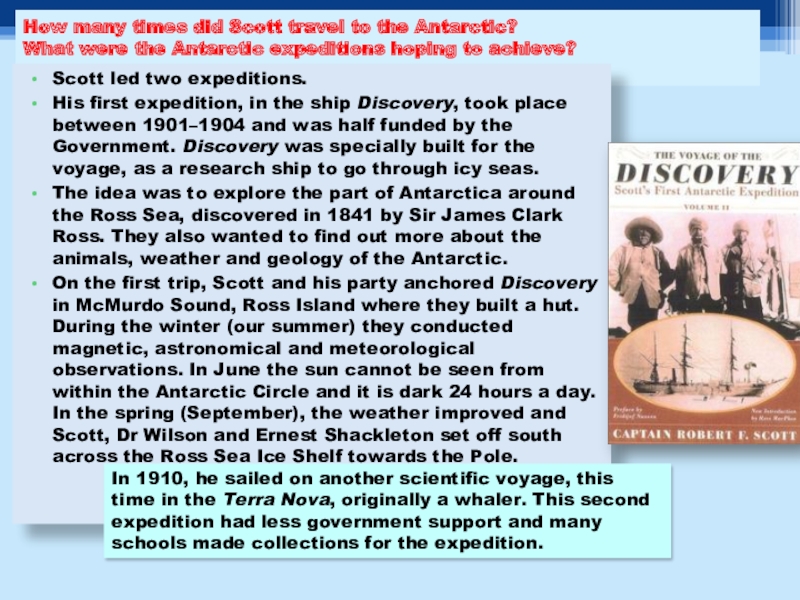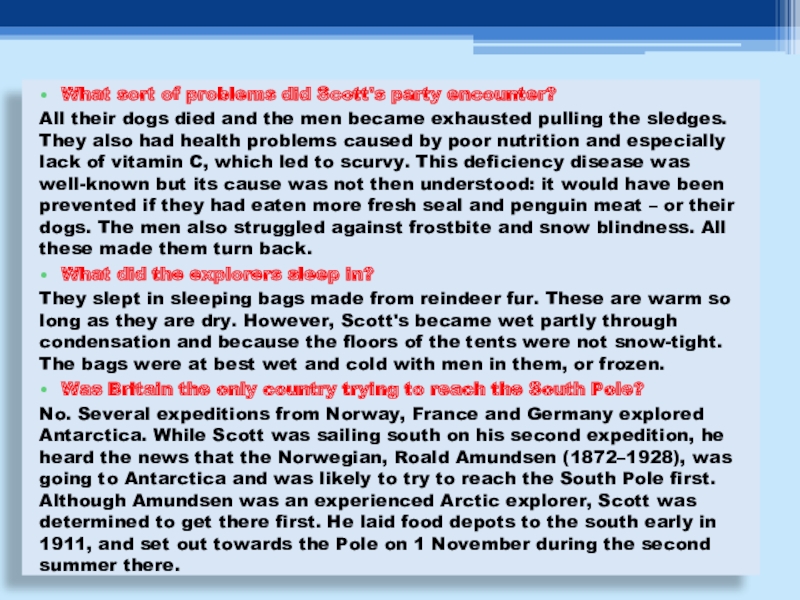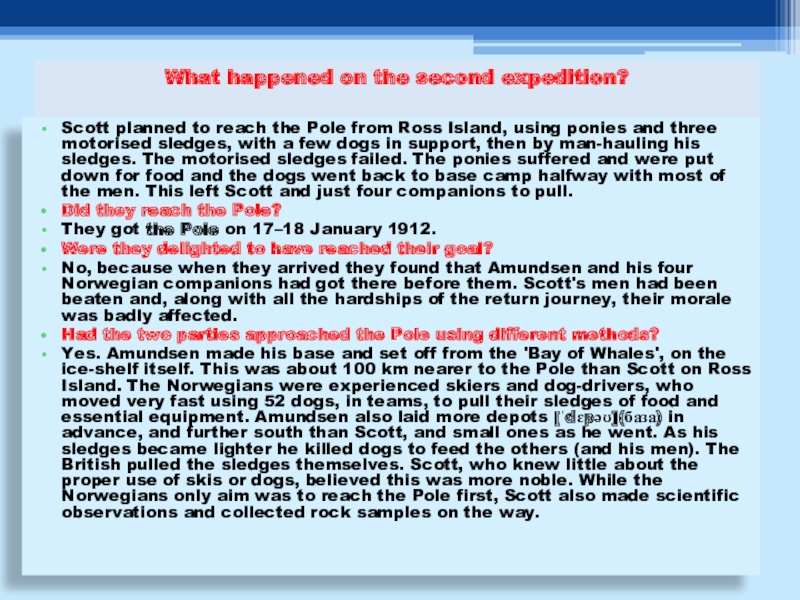Слайд 1УМК К. Кауфман, М. Кауфман
«Happy English.ru»
7 класс
Unit 9
Lessons2,3
презентация создана
учителем английского языка
МОУ «Лямбирская СОШ №1»
Егорчиковой К. М.
Robert Scott
Antarctic Pioneer
Слайд 2What is Antarctica?
Until the end of
the 19th century, only sealers and whalers had set foot on the desolate southern land we call Antarctica. Until as late as 1820, no one had even seen its mainland. In the 1890s however, explorers of various countries began to compete for being the first to reach both the North and the South Poles.
In 1901–1904 Captain Robert Falcon Scott (1868–1912) was the first person to explore Antarctica extensively by land.
Antarctica is an enormous continent. Britain could fit into it more than 50 times. More than 99 per cent of it is covered by ice. In places, this ice is more than three miles thick. Antarctica is completely surrounded by the vast Southern Ocean, half of which freezes in winter. It is high, windy and extremely cold. There is no indigenous human population and no life forms at all except around the coast.
Слайд 3Did explorers before Captain Scott try to reach the Antarctic?
Yes. For
instance, one aim of Captain Cook on his second Pacific voyage of 1772–1774, was to find the great southern continent. He sailed all round Antarctica but ice and fog prevented him from getting far enough south to see it. Cook decided that people would probably never travel further south than latitude 71 degrees, the position he reached. This was still more than 1000 miles from the Pole.
Слайд 4Who was Captain Scott?
Robert Falcon Scott was an
officer in the Royal Navy, who had joined his first ship when he was 13. He was born in Devon and came from seafaring family, though his father ran a brewery. Strict discipline and intense training prepared him for naval life. He was a promising young officer.
In 1899 he found his opportunity. While talking with the president of the Royal Geographical Society, Sir Clements Markham, Scott heard about a planned Antarctic expedition and he applied to be in command. In Scott, Markham saw the qualities he wanted from an expedition leader and so selected him to head the Discovery expedition. Scott’s path as an Antarctic explorer was set.
Слайд 5How many times did Scott travel to the Antarctic?
What were the
Antarctic expeditions hoping to achieve?
Scott led two expeditions.
His first expedition, in the ship Discovery, took place between 1901–1904 and was half funded by the Government. Discovery was specially built for the voyage, as a research ship to go through icy seas.
The idea was to explore the part of Antarctica around the Ross Sea, discovered in 1841 by Sir James Clark Ross. They also wanted to find out more about the animals, weather and geology of the Antarctic.
On the first trip, Scott and his party anchored Discovery in McMurdo Sound, Ross Island where they built a hut. During the winter (our summer) they conducted magnetic, astronomical and meteorological observations. In June the sun cannot be seen from within the Antarctic Circle and it is dark 24 hours a day. In the spring (September), the weather improved and Scott, Dr Wilson and Ernest Shackleton set off south across the Ross Sea Ice Shelf towards the Pole.
In 1910, he sailed on another scientific voyage, this time in the Terra Nova, originally a whaler. This second expedition had less government support and many schools made collections for the expedition.

Слайд 6What sort of problems did Scott's party encounter?
All their dogs died
and the men became exhausted pulling the sledges. They also had health problems caused by poor nutrition and especially lack of vitamin C, which led to scurvy. This deficiency disease was well-known but its cause was not then understood: it would have been prevented if they had eaten more fresh seal and penguin meat – or their dogs. The men also struggled against frostbite and snow blindness. All these made them turn back.
What did the explorers sleep in?
They slept in sleeping bags made from reindeer fur. These are warm so long as they are dry. However, Scott's became wet partly through condensation and because the floors of the tents were not snow-tight. The bags were at best wet and cold with men in them, or frozen.
Was Britain the only country trying to reach the South Pole?
No. Several expeditions from Norway, France and Germany explored Antarctica. While Scott was sailing south on his second expedition, he heard the news that the Norwegian, Roald Amundsen (1872–1928), was going to Antarctica and was likely to try to reach the South Pole first. Although Amundsen was an experienced Arctic explorer, Scott was determined to get there first. He laid food depots to the south early in 1911, and set out towards the Pole on 1 November during the second summer there.

Слайд 7They had some sledge-dogs but did not really know how to
use them, so largely pulled the sledges themselves.
All their dogs died and the men became exhausted pulling the sledges. They also had health problems caused by poor nutrition and especially lack of vitamin C, which led to scurvy. This deficiency disease was well-known but its cause was not then understood: it would have been prevented if they had eaten more fresh seal and penguin meat – or their dogs.
The men also struggled against frostbite and snow blindness. All these made them turn back.
Scott travelled slightly further than 82 degrees south, much further than anyone before but it was a terrible journey.
Слайд 8What happened on the second expedition?
Scott planned to reach the Pole
from Ross Island, using ponies and three motorised sledges, with a few dogs in support, then by man-hauling his sledges. The motorised sledges failed. The ponies suffered and were put down for food and the dogs went back to base camp halfway with most of the men. This left Scott and just four companions to pull.
Did they reach the Pole?
They got the Pole on 17–18 January 1912.
Were they delighted to have reached their goal?
No, because when they arrived they found that Amundsen and his four Norwegian companions had got there before them. Scott's men had been beaten and, along with all the hardships of the return journey, their morale was badly affected.
Had the two parties approached the Pole using different methods?
Yes. Amundsen made his base and set off from the 'Bay of Whales', on the ice-shelf itself. This was about 100 km nearer to the Pole than Scott on Ross Island. The Norwegians were experienced skiers and dog-drivers, who moved very fast using 52 dogs, in teams, to pull their sledges of food and essential equipment. Amundsen also laid more depots [ˈdɛpəʊ](база) in advance, and further south than Scott, and small ones as he went. As his sledges became lighter he killed dogs to feed the others (and his men). The British pulled the sledges themselves. Scott, who knew little about the proper use of skis or dogs, believed this was more noble. While the Norwegians only aim was to reach the Pole first, Scott also made scientific observations and collected rock samples on the way.

Слайд 9How far did they need to travel back to reach safety?
Scott
and his party needed to return across the 800 miles they had already covered. They had to be back before the middle of April, before the Antarctic winter brought deadly freezing temperatures and constant darkness.
What happened to them?
They had a disastrous time. Terrible weather included blizzards (сильная метель) and gale force winds. They had only limited and poor food, and shortage of fuel. Eventually, they all died. Evans died first, probably after knocking his head during a fall into a crevasse (расселина в леднике). Oates knew he was suffering from severe frostbite in his feet, could not go on, and did not want to slow the others down. On 17 March 1912, he left the tent during a blizzard. His final words,written down by Scott, were: 'I am just going outside, and I may be some time'. He was never seen again. The other three died in their tent during a blizzard at the end of March. They were only 11 miles from the next food and fuel depot.
Слайд 10How do we know about what happened to Scott?
A search party
was sent out from McMurdo Sound after the end of the Antarctic winter of 1912. It found the bodies of Scott, Dr Wilson and 'Birdie' Bowers on 12 November. They were in their sleeping bags inside a tent covered with snow. Their journals and papers were recovered but the bodies were left, wrapped in the tent and buried under a snow cairn (груда камней). News of the tragedy only reached Britain in February 1913. A huge memorial service, led by the King, was held in St Paul's Cathedral soon afterwards.
When a search party found the bodies, they discovered Scott’s diary in which he described their harrowing last weeks: strenuous sledge hauling, severe frostbite, lack of food and fuel, unusually cold temperatures and violent blizzards. He knew they would die. To add to their misfortunes, they had been beaten to the Pole by the Norwegian explorer Roald Amundsen.
Слайд 11Captain Scott made his last entry in his diary on 29
March 1912.
"Had we lived, I should have had a tale to tell of the hardihood, endurance, and courage of my companions which would have stirred the heart of every Englishman. These rough notes and our dead bodies must tell the tale." - Robert Falcon Scott, last diary.
“Если бы мы остались в живых, то какую бы я поведал повесть о твердости, выносливости и отваге своих товарищей, растревожившую бы сердце каждого англичанина! Мои неровные строки и наши мертвые тела должны поведать эту повесть…”
— Из «Послания к общественности», написанного на Шельфовом леднике Росса. Источник: Скотт Р. Экспедиция к Южному полюсу. 1910—1912 гг. Прощальные письма / Пер. с англ. В. А. Островского, Под ред. М. Г. Деева. — Москва: Дрофа. — ISBN 978-5-358-0547
Слайд 12Интернет-источники, использованные для презентации:
http://www.rmg.co.uk/explore/sea-and-ships/facts/explorers-and-leaders/scott
http://www.encyclopedia.com/topic/Robert_Falcon_Scott.aspx
http://www.datagate.stockindexonline.com/index.php?q=keyword_search
http://korabox.ru/category/news/antarkticheskaya_stanciya_na_ujnom_pol
http://mirokeana.selgatrend.ru/ujnijokean/ujnijokean_morja/350-izuchen…
http://www.localhistories.org/scott.html
http://en.ela.mobi/?text=джеймс+кук
http://www.bl.uk/turning-the-pages/?id=152707d0-a674-11db-a95e-0050c2490048&type=book